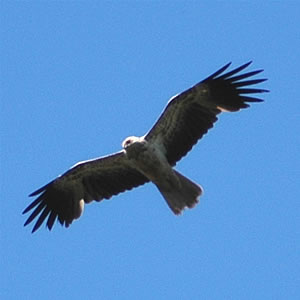- Whistling Kite
Taxobox
name = Whistling Kite
status = LC
status_system = iucn3.1
status_ref = [IUCN2006|assessors=BirdLife International|year=2004|id=49332|title=Haliastur sphenurus|downloaded=11 May 2006]

regnum =Animal ia
phylum = Chordata
classis = Aves
ordo =Falconiformes
familia =Accipitridae
genus = "Haliastur "
species = "H. sphenurus"
binomial = "Haliastur sphenurus"
binomial_authority = (Vieillot, 1818)The Whistling Kite "(Haliastur sphenurus)" is a medium-sized diurnal raptor found throughout
Australia (including coastalislands ),New Caledonia and much ofNew Guinea (excluding the centralmountains and the northwest).cite book |editor= Josep del Hoyo|others= Andrew Elliott, Jordi Sargatal |title=Handbook of the Birds of the World, volume 2 |year= 1994 |publisher= Lynx Edicions |location= Barcelona |isbn =8487334156] Also sometimes erroneously called Whistling Eagle or Whistling Hawk, it is named for its loud whistling call, which it often gives in flight. Some authorities put this species in thegenus "Milvus ",cite book | last = Slater | first = Peter | coauthors = Pat Slater, Raoul Slater | title = The Slater Field Guide to Australian Birds | year = 1986 | publisher = Reed New Holland | location = Sydney | isbn = 1877069000 ] despite marked differences in behaviour, voice andplumage between this species and other members of that genus.Description
The Whistling Kite ranges in size from 50–60 cm, with a
wingspan between 123–146 cm. Weights range from 380–1050 g. As with most raptors,female s are larger and heavier thanmale s; though there is considerable overlap between the sexes, females can be up to 21% larger and 42% heavier.cite book | last = Ferguson-Lees | first = James | coauthors = David A. Christie | title = Raptors of the World | year = 2001 | publisher = Christopher Helm | location = London | isbn = 0713680261 ] Southern birds are also larger than those found in the tropics. Male and female plumages are the same. Adult birds are a pale buff on the head, breast and tail, with browner wings and blackflight feather s. Immature birds are a heavily-streaked reddish-brown with prominent pale spots on the wings. Throughout their lives, Whistling Kites have bone-colored legs and feet, which are unfeathered. Overall, the Whistling Kite looks small-headed and long-tailed, with wingtips falling well short of the tail tip when the bird is perched. Though its legs are short, the bird walks easily on the ground. Whistling Kites soar on slightly bowed wings, with their long flight feathers often well-splayed. The striking pattern on their underwings is distinctive.Voice
This is a noisy species, calling regularly in flight and while perched—even while at the nest. Its most common call is a clear descending whistle, often followed (less often preceded) by a rapid series of rising notes.cite book | last = Pizzey | first = Graham | coauthors = Frank Knight |title = Birds of Australia | year = 1997 | publisher = HarperCollins | location = London | isbn = 0002201321 ] Intriguingly, field research carried out in Taunton Scientific National Park, Central
Queensland by Fiona Randall from theUniversity of Edinburgh ,Scotland has shown thatSpotted Bowerbird s ("Chlamydera maculata") in that park regularly mimic the calls of Whistling Kites, with the frequency ofmimicry increasing as the breeding season progresses. [ cite web | last = Randall | first = Fiona | title = Vocal Mimicry in Spotted Bowerbirds | date = 2002 | url = http://student.biology.ed.ac.uk/general/awards/reports/2002_rennie/Rennie-Report-Randall.pdf | accessdate = 2007-04-24 ] The function of this mimicry is unknown.Habitat
A species of open or lightly wooded areas, Whistling Kites are typically found near water, at elevations ranging from sea level to 1400 meters. Though the species as a whole is generally sedentary, some Australian birds are known to be nomadic, wandering to
coastal areas in northern Australia during thedry season ; some south Australian birds migrate to the south in the autumn. There is some evidence that the species is declining locally in southern Australia due to the drainage ofwetlands and an accompanying decline in food supplies.Behaviour
Whistling Kites tend to be found singly or in pairs, but sometimes gather in larger groups, particularly during nomadic movements, at roost sites and at sources of plentiful food.
Feeding
Whistling Kites are truly catholic in their tastes, taking small
mammal s,bird s,fish ,reptile s,amphibian s,crustacean s,insect s andcarrion . Those in Australia tend to take primarily liveprey (except in thewinter , when they subsist largely on carrion), while those in New Guinea are principallyscavenger s. Most food items are taken either from the ground or from the water surface, though insects are sometimes hawked directly from the air. Whistling Kites are also known to pirate meals fromibis es andheron s and from other raptors, and to force large waterbirds to regurgitate their catches. They regularly patrol roads in search of roadkill, and hover over the edges of grass fires in search of potential prey fleeing the flames.Breeding
The Whistling Kite’s nest is a bulky platform made of sticks and lined with green leaves, placed in an upright fork of a tall
tree —often aeucalypt orpine in ariparian area. Pairs often re-use the same nest year after year, annually adding material until the platform becomes quite large. Females normally lay 2–3 bluish-white eggs, which are sometimes covered with reddish-brown blotches; clutches of 1–4 eggs have been recorded. Eggs are incubated for 35–40 days, and the species is reported to have a 60% hatching success. Chicks, which are covered with cream- or buff-colored down feathers, spend 44–54 days in the nest before fledging, and are dependent on their parents for a further 6–8 weeks after leaving the nest. In Australia, the birds generally breed between June and October in the south, and between February and May in the north, though they may nest at any time after rain providing there are adequate food supplies.References
External links
* [http://student.biology.ed.ac.uk/general/awards/reports/2002_rennie/Rennie-Report-Randall.pdf "Vocal Mimicry in Spotted Bowerbirds" - Field study report by Fiona Randall discussing mimicry of Whistling Kites]
* [http://www.hbw.com/ibc/phtml/especie.phtml?idEspecie=600 Whistling Kite videos on the Internet Bird Collection]
* [http://photogallery.canberrabirds.org.au/raptors.htm#WHKI Whistling Kite photos on the Canberra Ornithologists Group website]
Wikimedia Foundation. 2010.
